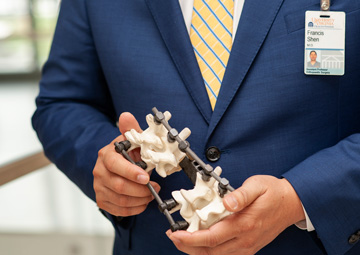
Titanium and steel spinal implants have long been used to treat everything from infections and trauma to degenerative conditions and spine tumors. But the metal hardware limits post-operative radiotherapy and the use of magnetic imaging for spinal tumor management. Now, UVA Health is one of the few U.S. hospitals offering an alternative, low-metal composite device for spine tumor patients.
A new polyetheretherketone/carbon fiber (PEEK/CF) pedicle screw and vertebral body replacement (VBR) system delivers a number of benefits, including better tumor surveillance and higher accuracy for post-surgical radiation therapy, says orthopedic surgeon Francis Shen, MD, co-director of UVA Health Spine Center.
“Low-metal spine implants don’t cure spinal tumors, but they may make living with them more manageable. They also allow oncologists to monitor and treat tumors more accurately,” Shen explains.
Low-Metal Technology Is More Radiolucent
Traditional titanium and steel spine implants are successfully used to decompress and stabilize the spine in cases of trauma, infection, and degeneration. They are also used in patients with spine tumors.
But they contain metal, which interferes with magnetic imaging and scatters radiation. Their metal hardware can make follow-up care less efficient and reliable.
The new PEEK/CF implant appears to stabilize the spine just as successfully as its titanium and steel counterparts, but unlike titanium and steel, PEEK/CF is radiolucent. That means it allows post-surgical tumor radiation therapy to be highly targeted and accurate.
Better Technology, Improved Patient Care
Standard care for spine tumors includes both surgical and medical management, including radiation therapy. And the success or failure of radiation treatment depends on the dose and accuracy of the therapy that’s delivered.
When traditional metal implants are in place, radiation waves scatter, delivering widespread radiation rather than targeted treatment. This dilutes the treatment to the intended area and exposes the patient to radiation in unintended areas. Using a composite PEEK/CF implant allows for more concentrated radiation therapy, thereby lowering overall exposure.
Additionally, PEEK/CF doesn’t interfere with magnetic imaging, allowing oncologists to better monitor for tumor growth and metastasis — possibly resulting in earlier detection and less invasive treatments.
“At UVA Health, our surgeons and oncologists are committed to improving post-surgical care for our spine tumor patients,” says Shen. “It’s too early to tell how the new low-metal implant will affect spine tumor prognoses in the future, but it has proven to be better for post-surgical surveillance and radiation therapy. And that’s a step in the right direction.”
Who’s Eligible for the PEEK/CF Spine Implant
The best candidates for the low-metal PEEK/CF implant have “the ideal anatomy and tumor extent,” meaning patients who have well-aligned anatomy with wide enough vertebrae to allow for proper anchoring, Shen shares.
“Unfortunately, that means patients with significant loss of spinal alignment and children (since they have smaller bones), at this time, aren’t eligible for the implant,” Shen says. “Also, the device is only approved for use on patients with spine tumors. It’s our hope, though, that eventually, it’ll be suitable for all types of spinal conditions, including degenerative ones.”
In terms of tumor extent, Shen explains that patients with tumors that are widely metastatic may not receive enough benefit to warrant the surgery. “As improvements are made to the device in the near future, we’re optimistic the percentage of good candidates will increase," he says.
Looking Ahead Toward Full Spine Usage
The FDA hasn’t approved the implant for use on degenerative spinal conditions, spine trauma, or spinal infections. But Shen indicates those uses are coming.
“The goal is to use low-metal, PEEK/CF implants for all spinal conditions," Shen shares. "While there are no long-term data yet to support how this device will hold up in patients with life-long, degenerative conditions, the durability of carbon fiber technology has been used successfully and demonstrated for years in things like cars and airplanes. Early evidence suggests that low metal, PEEK/CF technology performs similarly in biologic systems."
PEEK/CF spinal implants have been shown to deliver superior tumor surveillance and allow for more targeted, concentrated radiation therapy. This makes spine surgeons like Shen optimistic that this is only the beginning.
“As important as this technology is for spine tumor patients, it’s equally important that we continue to improve the technology used for all spine surgeries,” Shen says. “It’s just one part of UVA Health’s bigger commitment to improving patient care for all.”
